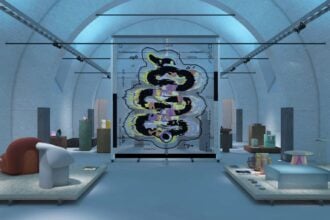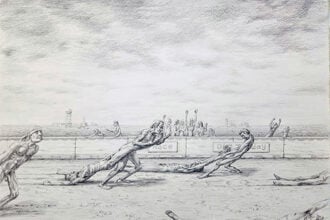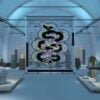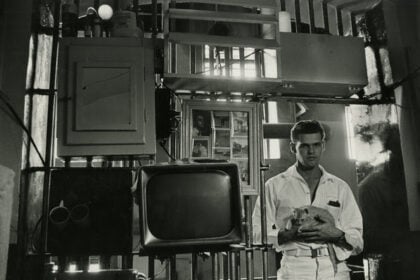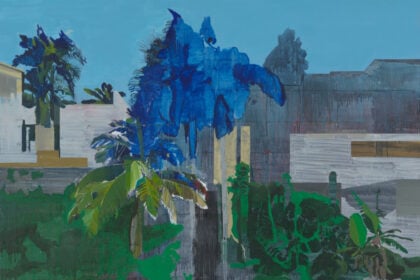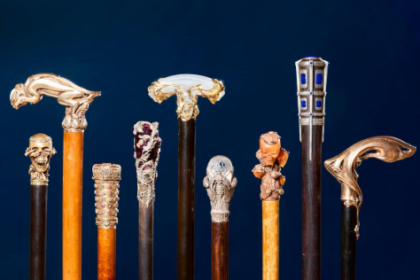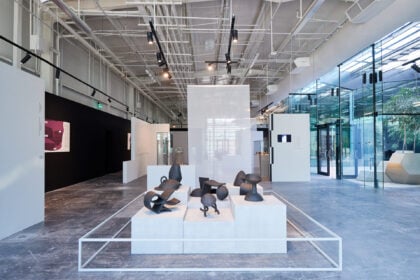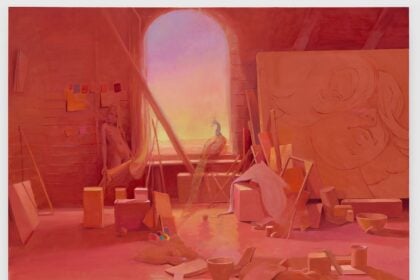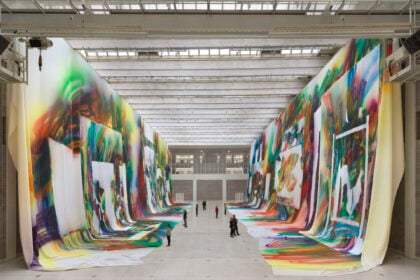Alexander Gray Associates contextualizes recent work by Ricardo Brey and Ruby Sky Stiler alongside a historic composition by Romare Bearden. Bringing together sculpture, painting, collage, and works on paper, the Gallery’s presentation highlights the three artists’ complex relationships to abstraction, assemblage, and the human subject.
Foregrounding the presentation is Romare Bearden’s lush collage, The Two Moons of Morning (1972). Expanding the academic tradition of the female nude, Bearden’s lyrical image centers a seated woman amid verdant settings. Known for his powerful depictions of the Black American experience, Bearden grew increasingly disillusioned with abstraction over the course of his career, turning instead to innovative deployments of collage and photomontage with works such as The Two Moons of Morning. The excised photograph forming the work’s primary figure manifests Bearden’s commitment to amending art history through strategic odes to “the beauty of black woman.” In his celebration of Black beauty, Bearden asserts the exuberance of his subject matter through the abundance of his accumulated materials. By these means, Bearden attests that Black American life is “perhaps the richest because it is the one lifestyle that is talking about life and about the continuation of life … and through all of the anguish—the joy of life.”
Similarly, Ricardo Brey’s sculptures illuminate a holistic approach to cross-cultural experience and the human condition, uniting Western and non-Western visual vocabularies through modes of assemblage. Brey’s bricolage reimaginings of the Santaría pantheon—including Eshu and Iyalocha (both 2023)—marry together Classical motifs with an undeniably Caribbean frame of aesthetic reference that is uniquely his own. Brey’s foregrounding of darkened and decoratively amended replicas of antique sculpture asserts a syncretic relationship between African visual culture and Western antiquity. In the artist’s words, “the sculptures stand for a moment in time when the ‘great origins of European civilisations,’ looked to the African continent with so much awe and respect that they ended up integrating their imagery into their own culture.”
Just as the artist’s assemblages echo processes of “creolization” within the African diaspora, so too do Brey’s all-blue works on paper provide conceptual models through which multiplicity can be captured. His ambient scenes such as Traces of Light and Weeping Willow (both 2023) embrace the enigmatic, non-reductive forms of the natural world. Foregrounding expansive natural environments, the artist champions both the resilience of nature and the hybrid human subjects who populate it.
The work of Ruby Sky Stiler is likewise invested in a feminist ethic to find what the artist describes as “commonality between human beings.” Recalling modernist block printed textiles, Stiler’s relief paintings such as Artist With Blue Palette (2023) subvert the genre of self-portraiture, reinserting the woman artist as an archetype back into the art historical canon. Through her engagement with collage and dialects of twentieth century abstraction, Stiler combats histories of female objectification. Along these lines, canvases like Two Figures in Blue (2023) are both material amalgams composed of heavy watercolor paper, acrylic paint, and graphite drawings applied to wooden panels, and multilayered interventions into the history of the nude.
Her sculptures similarly complicate the history of the nude while staking out a productive tension between the monumental and the prop-like—as well as the geometric and the organic. With Rose Bathers (2021), Stiler evokes modernist paintings of nude figures who stand before bodies of water, socially balancing the composition by including of male figures and children. To this end, Stiler creates images and models that recall the past while reflecting the ever-shifting expressions, expectations, and aspirations of the present.
Variously reworking fragments of material and visual culture, the works featured in the Gallery’s presentation reinsert omitted subjects into histories of representation. Channeling the past through modes of collage, assemblage, and more, the works on view offer renewed perspectives for understanding the present. Each work, by its own unique means and methods, recalls Stiler’s humanist conviction that art “is like research and development for the greater good; it’s a space for therapy and spirit … it’s a reflection of ideals.”



